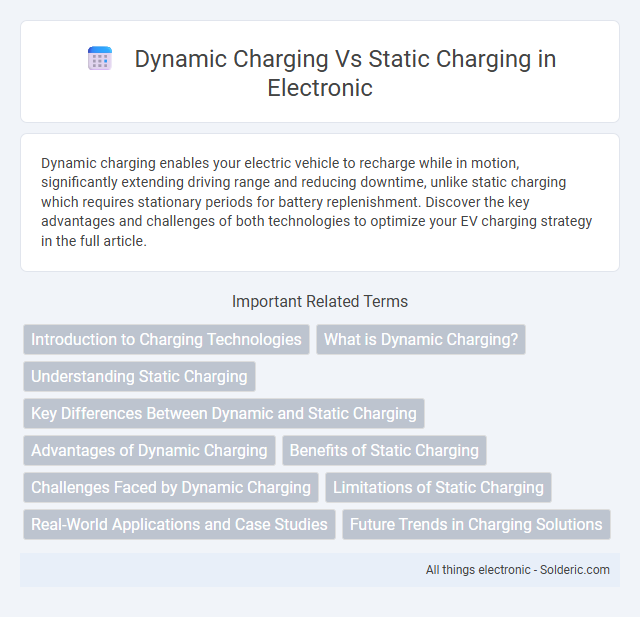Dynamic charging enables your electric vehicle to recharge while in motion, significantly extending driving range and reducing downtime, unlike static charging which requires stationary periods for battery replenishment. Discover the key advantages and challenges of both technologies to optimize your EV charging strategy in the full article.
Comparison Table
| Feature | Dynamic Charging | Static Charging |
|---|---|---|
| Definition | Charging electric vehicles while in motion. | Charging electric vehicles while stationary. |
| Use Case | Highways, bus lanes, and fleet routes. | Residential, commercial, and public charging points. |
| Infrastructure | Embedded road coils or conductive rails. | Charging stations with plugs or wireless pads. |
| Charging Speed | Moderate, continuous energy transfer. | Variable: slow to fast, based on charger type. |
| Vehicle Requirements | Special receivers and compatible EVs. | Standard EV charging ports. |
| Cost | High initial infrastructure investment. | Lower installation cost, scalable. |
| Convenience | Minimal downtime for charging. | Requires stopping time to charge. |
| Energy Efficiency | Moderate, energy loss due to transfer in motion. | High, direct energy transfer when stationary. |
| Adoption Stage | Experimental and limited deployment. | Widely adopted globally. |
Introduction to Charging Technologies
Dynamic charging enables electric vehicles to recharge while in motion using embedded roadway systems, offering continuous energy supply and reducing range anxiety. Static charging relies on stationary charging stations where vehicles must be parked for a period to replenish their battery, typically through Level 2 AC chargers or DC fast chargers with varying power outputs. Advances in conductive and inductive charging technologies drive improvements in efficiency, speed, and accessibility across both dynamic and static methods.
What is Dynamic Charging?
Dynamic charging refers to the process of wirelessly charging electric vehicles while they are in motion, using embedded infrastructure like inductive coils installed in roadways. This technology enables continuous power transfer to your vehicle, reducing reliance on stationary charging stops and extending driving range. It contrasts with static charging, where vehicles must be parked to connect to a charging station.
Understanding Static Charging
Static charging refers to the process of charging an electric vehicle (EV) while it is stationary, typically through a dedicated charging station connected to the power grid. This method allows for controlled, high-power energy transfer, often resulting in faster and more efficient battery replenishment. Static charging infrastructure includes home chargers, public charging points, and workplace stations, which provide reliable and predictable energy delivery.
Key Differences Between Dynamic and Static Charging
Dynamic charging involves transferring energy to electric vehicles while in motion, enabling continuous power supply and reducing range anxiety. Static charging requires vehicles to be stationary, typically using standard charging stations with varying power levels and charging times. Your choice depends on convenience, infrastructure availability, and whether uninterrupted driving or slower, stable charging is more suitable.
Advantages of Dynamic Charging
Dynamic charging offers the advantage of continuous energy supply to electric vehicles while in motion, significantly extending driving range without frequent stops. This technology reduces downtime by eliminating the need for stationary charging sessions, enhancing convenience and operational efficiency for public transportation and commercial fleets. It also supports infrastructure scalability by integrating charging into existing roadways, optimizing space and reducing the demand for large parking-based charging stations.
Benefits of Static Charging
Static charging offers consistent energy transfer efficiency by allowing vehicles to charge while parked, eliminating the need for complex moving infrastructure. This method provides reliable power delivery with minimal maintenance costs, ensuring stable energy flow without interruptions. Static charging stations are more cost-effective to install and maintain due to established technology and standardized connectors.
Challenges Faced by Dynamic Charging
Dynamic charging faces significant challenges including high infrastructure costs, complex integration with existing road systems, and the need for precise vehicle alignment to maintain efficient energy transfer. Safety concerns related to electromagnetic fields and weather resistance also impact the widespread adoption of this technology. To optimize your experience, overcoming these obstacles is crucial for reliable and seamless power delivery while vehicles are in motion.
Limitations of Static Charging
Static charging faces significant limitations such as restricted range due to the necessity of stationary contact points for power transfer, resulting in frequent stops and longer charging times. Infrastructural constraints also arise from the need for extensive installation of charging stations, leading to high costs and limited accessibility in remote areas. This contrasts sharply with dynamic charging systems that enable continuous power delivery while in motion, effectively reducing downtime and extending vehicle range.
Real-World Applications and Case Studies
Dynamic charging enables electric vehicles (EVs) to charge while in motion, reducing downtime and extending driving range in urban environments, as demonstrated by pilot projects in countries like Sweden and South Korea. Static charging stations, prevalent worldwide, offer reliable and fast recharge points for parked EVs, essential for residential and commercial fleets. Your choice between these technologies depends on use cases, infrastructure availability, and the specific demands of your operation or lifestyle.
Future Trends in Charging Solutions
Future trends in charging solutions emphasize dynamic charging systems that enable electric vehicles (EVs) to recharge while in motion using embedded road technology, significantly reducing downtime and range anxiety. Static charging, characterized by stationary charging stations, continues to evolve with faster charging speeds and wireless capabilities but remains limited by fixed locations. Integration of smart grids and renewable energy sources will drive the adoption of dynamic charging, positioning it as a pivotal advancement in sustainable urban mobility and infrastructure development.
Dynamic charging vs Static charging Infographic

 solderic.com
solderic.com